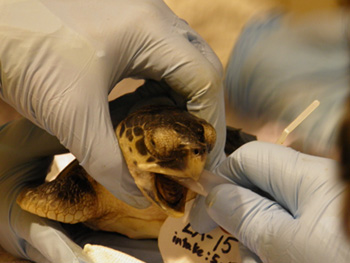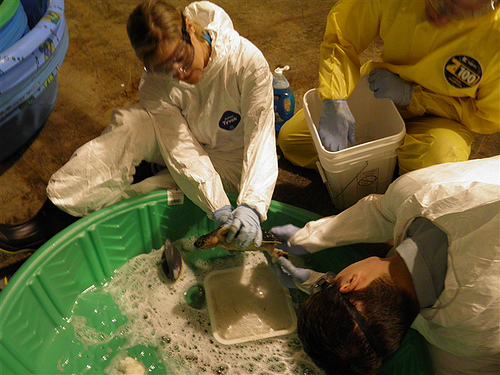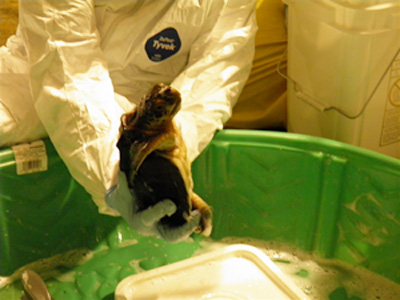
Audubon/Louisiana Marine Mammal <a href="http://www.flickr.com/photos/50286514@N05/sets/72157623970329897/">via Flickr.</a>
Meet this uglorable lil’ guy, a baby Kemp’s Ridley sea turtle who I’ll call Kurt. Kurt the turtle is in the middle of having his mouth washed out not because he said a swear word, but because BP decided to take a few safety “shortcuts.” Named after Florida naturalist and fisherman Richard Kemp who discovered the species in 1880, the Kemp’s Ridleys are the most endangered sea turtles in the world. Slight by nature, Kemp’s are also the smallest marine turtles in the world: adults weigh only 100 lbs. A hundred pounds may seem like a lot until you learn that the Loggerhead sea turtle clocks in at about 300 lbs, and the Hawksbill sea turtle weighs around 200 lbs. Compared to them, the Kemp’s is positively svelte.
Kurt the Kemp’s Ridley (above) is just a juvie, though, and he’s one of at least four Kemp’s reportedly mired by the BP spill. However, there could be additional casualties obscured by Fish & Wildlife’s large number of uncategorized wildlife. In addition, Kemp’s Ridleys nest during the summer on the east coast of Mexico, in the state of Tamaulipas, meaning some will likely have to traverse the increasingly soiled Gulf to get there.
Currently, the biggest threat to Kemp’s Ridleys is…wait for it…humans. Earlier in the 1900s, Kemp’s nearly went extinct after their eggs were over-harvested as a food source. Although their Mexican and Texas breeding grounds were protected starting in the 1960s and 70s, they’re still having a hard time rebounding due to commercial fishers and shrimpers which accidentally scoop up the turtles as they swim or feed on crabs and shellfish. Humans have been making some amends, through conservation programs and even ecotourism. Mexican tourists near certain beaches can protect hatchlings from predators as the animals make their way from nest to the sea. At least one resort goes a step further due to its location right by a turtle nesting site: “When the sea turtles come ashore to lay their eggs and let nature take its course, they face a tiny obstacle: nature has a big resort sitting on it. Problem solved when the resort staff transports the eggs to a nursery for incubation. Once the eggs hatch—after about 45 days—the baby sea turtles are ready to enter the wild.”
As Kurt the turtle was not available for interviews, I have no idea how he got into the ocean. But I do know that these turtles need all the help they can get, and the BP spill? Not helping. As consolation, a few more pics below of Kurt getting a bath.












